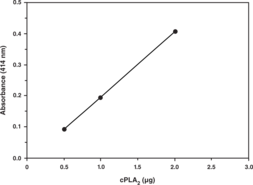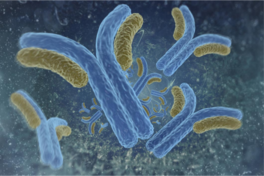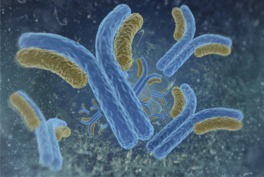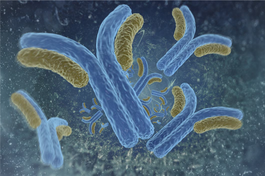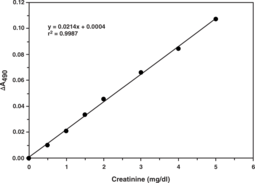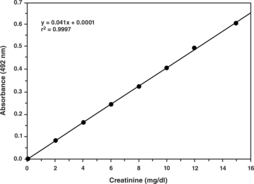Cayman
Showing 16351–16500 of 45550 results
-
(+)-JQ1 (Item No. 11187) binds to the acetyl-lysine recognition pocket of bromodomains 1 and 2 on BRD4 with Kd values of ~50 and 90 nM, respectively.{19044} This displaces BRD4 from nuclear chromatin in cells, inducing differentiation and growth arrest in midline carcinoma cells.{19044} CPI-203 is a primary amide analog of (+)-JQ1 which has shown superior bioavailability with oral or i.p. administration.{24965} It is comparable or superior to (+)-JQ1 in inhibiting BRD4 binding and action in vitro or in cells.{24965,24964} CPI-203 arrests the growth of leukemic T cells in vitro (EC50 = 91 nM) and rapidly suppresses leukemia burden in mice.{24965}
Brand:CaymanSKU:-(+)-JQ1 (Item No. 11187) binds to the acetyl-lysine recognition pocket of bromodomains 1 and 2 on BRD4 with Kd values of ~50 and 90 nM, respectively.{19044} This displaces BRD4 from nuclear chromatin in cells, inducing differentiation and growth arrest in midline carcinoma cells.{19044} CPI-203 is a primary amide analog of (+)-JQ1 which has shown superior bioavailability with oral or i.p. administration.{24965} It is comparable or superior to (+)-JQ1 in inhibiting BRD4 binding and action in vitro or in cells.{24965,24964} CPI-203 arrests the growth of leukemic T cells in vitro (EC50 = 91 nM) and rapidly suppresses leukemia burden in mice.{24965}
Brand:CaymanSKU:-(+)-JQ1 (Item No. 11187) binds to the acetyl-lysine recognition pocket of bromodomains 1 and 2 on BRD4 with Kd values of ~50 and 90 nM, respectively.{19044} This displaces BRD4 from nuclear chromatin in cells, inducing differentiation and growth arrest in midline carcinoma cells.{19044} CPI-203 is a primary amide analog of (+)-JQ1 which has shown superior bioavailability with oral or i.p. administration.{24965} It is comparable or superior to (+)-JQ1 in inhibiting BRD4 binding and action in vitro or in cells.{24965,24964} CPI-203 arrests the growth of leukemic T cells in vitro (EC50 = 91 nM) and rapidly suppresses leukemia burden in mice.{24965}
Brand:CaymanSKU:-(+)-JQ1 (Item No. 11187) binds to the acetyl-lysine recognition pocket of bromodomains 1 and 2 on BRD4 with Kd values of ~50 and 90 nM, respectively.{19044} This displaces BRD4 from nuclear chromatin in cells, inducing differentiation and growth arrest in midline carcinoma cells.{19044} CPI-203 is a primary amide analog of (+)-JQ1 which has shown superior bioavailability with oral or i.p. administration.{24965} It is comparable or superior to (+)-JQ1 in inhibiting BRD4 binding and action in vitro or in cells.{24965,24964} CPI-203 arrests the growth of leukemic T cells in vitro (EC50 = 91 nM) and rapidly suppresses leukemia burden in mice.{24965}
Brand:CaymanSKU:-CPI-268456 is a ligand of bromodomain-containing protein 4 (BRD4).{53006} It binds to BRD4 (IC50 = 50 = <0.5 µM).
Brand:CaymanSKU:20973 -Out of stock
CPI-268456 is a ligand of bromodomain-containing protein 4 (BRD4).{53006} It binds to BRD4 (IC50 = 50 = <0.5 µM).
Brand:CaymanSKU:20973 -Out of stock
CPI-268456 is a ligand of bromodomain-containing protein 4 (BRD4).{53006} It binds to BRD4 (IC50 = 50 = <0.5 µM).
Brand:CaymanSKU:20973 -Out of stock
CPI-268456 is a ligand of bromodomain-containing protein 4 (BRD4).{53006} It binds to BRD4 (IC50 = 50 = <0.5 µM).
Brand:CaymanSKU:20973 -Out of stock
CPI-360 is a selective EZH2 inhibitor with IC50 values of 0.5 and 2.5 nM for wild-type EZH2 and Y641N mutant EZH2, respectively.{29633} It decreases cellular levels of H3K27me3 and H3K27me2 (EC50s = 56 and 65 nM, respectively), triggering cell cycle arrest and ultimately resulting in apoptosis in a large panel of non-Hodgkin’s lymphoma (NHL) cell lines.{29633} Twice daily, subcutaneous administration of 200 mg/kg of CPI-360 reduced tumor growth of KARPAS-422 xenografts in mice.{29633}
Brand:CaymanSKU:-Available on backorder
CPI-360 is a selective EZH2 inhibitor with IC50 values of 0.5 and 2.5 nM for wild-type EZH2 and Y641N mutant EZH2, respectively.{29633} It decreases cellular levels of H3K27me3 and H3K27me2 (EC50s = 56 and 65 nM, respectively), triggering cell cycle arrest and ultimately resulting in apoptosis in a large panel of non-Hodgkin’s lymphoma (NHL) cell lines.{29633} Twice daily, subcutaneous administration of 200 mg/kg of CPI-360 reduced tumor growth of KARPAS-422 xenografts in mice.{29633}
Brand:CaymanSKU:-Available on backorder
CPI-360 is a selective EZH2 inhibitor with IC50 values of 0.5 and 2.5 nM for wild-type EZH2 and Y641N mutant EZH2, respectively.{29633} It decreases cellular levels of H3K27me3 and H3K27me2 (EC50s = 56 and 65 nM, respectively), triggering cell cycle arrest and ultimately resulting in apoptosis in a large panel of non-Hodgkin’s lymphoma (NHL) cell lines.{29633} Twice daily, subcutaneous administration of 200 mg/kg of CPI-360 reduced tumor growth of KARPAS-422 xenografts in mice.{29633}
Brand:CaymanSKU:-Available on backorder
CPI-360 is a selective EZH2 inhibitor with IC50 values of 0.5 and 2.5 nM for wild-type EZH2 and Y641N mutant EZH2, respectively.{29633} It decreases cellular levels of H3K27me3 and H3K27me2 (EC50s = 56 and 65 nM, respectively), triggering cell cycle arrest and ultimately resulting in apoptosis in a large panel of non-Hodgkin’s lymphoma (NHL) cell lines.{29633} Twice daily, subcutaneous administration of 200 mg/kg of CPI-360 reduced tumor growth of KARPAS-422 xenografts in mice.{29633}
Brand:CaymanSKU:-Available on backorder
CPI-444 is an antagonist of the adenosine A2A receptor.{42281} It reduces tumor area in mouse model of murine Her2/neu-expressing breast cancer.
Brand:CaymanSKU:25024 - 1 mgAvailable on backorder
CPI-444 is an antagonist of the adenosine A2A receptor.{42281} It reduces tumor area in mouse model of murine Her2/neu-expressing breast cancer.
Brand:CaymanSKU:25024 - 10 mgAvailable on backorder
CPI-444 is an antagonist of the adenosine A2A receptor.{42281} It reduces tumor area in mouse model of murine Her2/neu-expressing breast cancer.
Brand:CaymanSKU:25024 - 25 mgAvailable on backorder
CPI-444 is an antagonist of the adenosine A2A receptor.{42281} It reduces tumor area in mouse model of murine Her2/neu-expressing breast cancer.
Brand:CaymanSKU:25024 - 5 mgAvailable on backorder
CPI-455 is an inhibitor of the lysine demethylase 5 family (KDM5A-D).{39079} CPI-455 binds to the demethylase active site and selectively inhibits KDM5A-D (IC50s = 2-10 nM) over KDM2-4, 6, and 7 family members (IC50s = 1 to >25 μM). It increases histone H3K4me2/3 methylation in vitro and decreases the number of drug-tolerant cells in PC9 non-small cell lung, M14 melanoma, and SKBR3 breast cancer cell populations. CPI-455 also reduces growth of glioblastoma cells resistant to temozolomide (TMZ; Item No. 14163) in a dose-dependent manner.{39080}
Brand:CaymanSKU:22127 -Out of stock
CPI-455 is an inhibitor of the lysine demethylase 5 family (KDM5A-D).{39079} CPI-455 binds to the demethylase active site and selectively inhibits KDM5A-D (IC50s = 2-10 nM) over KDM2-4, 6, and 7 family members (IC50s = 1 to >25 μM). It increases histone H3K4me2/3 methylation in vitro and decreases the number of drug-tolerant cells in PC9 non-small cell lung, M14 melanoma, and SKBR3 breast cancer cell populations. CPI-455 also reduces growth of glioblastoma cells resistant to temozolomide (TMZ; Item No. 14163) in a dose-dependent manner.{39080}
Brand:CaymanSKU:22127 -Out of stock
CPI-455 is an inhibitor of the lysine demethylase 5 family (KDM5A-D).{39079} CPI-455 binds to the demethylase active site and selectively inhibits KDM5A-D (IC50s = 2-10 nM) over KDM2-4, 6, and 7 family members (IC50s = 1 to >25 μM). It increases histone H3K4me2/3 methylation in vitro and decreases the number of drug-tolerant cells in PC9 non-small cell lung, M14 melanoma, and SKBR3 breast cancer cell populations. CPI-455 also reduces growth of glioblastoma cells resistant to temozolomide (TMZ; Item No. 14163) in a dose-dependent manner.{39080}
Brand:CaymanSKU:22127 -Out of stock
CPI-455 is an inhibitor of the lysine demethylase 5 family (KDM5A-D).{39079} CPI-455 binds to the demethylase active site and selectively inhibits KDM5A-D (IC50s = 2-10 nM) over KDM2-4, 6, and 7 family members (IC50s = 1 to >25 μM). It increases histone H3K4me2/3 methylation in vitro and decreases the number of drug-tolerant cells in PC9 non-small cell lung, M14 melanoma, and SKBR3 breast cancer cell populations. CPI-455 also reduces growth of glioblastoma cells resistant to temozolomide (TMZ; Item No. 14163) in a dose-dependent manner.{39080}
Brand:CaymanSKU:22127 -Out of stock
Lipoic acid (Item No. 10005728) is a natural organosulfur compound that serves as a cofactor in various complexes, including the α-ketoglutarate dehydrogenase complex, which is involved in the citric acid cycle as well as other pathways. CPI-613 is a lipoic acid analog that inhibits α-ketoglutarate dehydrogenase, particularly in tumor cells.{27997} At 60-240 µM, CPI-613 induces a strong mitochondrial burst of reactive oxygen species, resulting in cell death.{27997} By disrupting mitochondrial metabolism, CPI-613 demonstrates both in vitro and in vivo anti-tumor activity through both apoptotic and non-apoptotic pathways.{27998,27996,27999}
Brand:CaymanSKU:-Out of stock
Lipoic acid (Item No. 10005728) is a natural organosulfur compound that serves as a cofactor in various complexes, including the α-ketoglutarate dehydrogenase complex, which is involved in the citric acid cycle as well as other pathways. CPI-613 is a lipoic acid analog that inhibits α-ketoglutarate dehydrogenase, particularly in tumor cells.{27997} At 60-240 µM, CPI-613 induces a strong mitochondrial burst of reactive oxygen species, resulting in cell death.{27997} By disrupting mitochondrial metabolism, CPI-613 demonstrates both in vitro and in vivo anti-tumor activity through both apoptotic and non-apoptotic pathways.{27998,27996,27999}
Brand:CaymanSKU:-Out of stock
Lipoic acid (Item No. 10005728) is a natural organosulfur compound that serves as a cofactor in various complexes, including the α-ketoglutarate dehydrogenase complex, which is involved in the citric acid cycle as well as other pathways. CPI-613 is a lipoic acid analog that inhibits α-ketoglutarate dehydrogenase, particularly in tumor cells.{27997} At 60-240 µM, CPI-613 induces a strong mitochondrial burst of reactive oxygen species, resulting in cell death.{27997} By disrupting mitochondrial metabolism, CPI-613 demonstrates both in vitro and in vivo anti-tumor activity through both apoptotic and non-apoptotic pathways.{27998,27996,27999}
Brand:CaymanSKU:-Out of stock
Lipoic acid (Item No. 10005728) is a natural organosulfur compound that serves as a cofactor in various complexes, including the α-ketoglutarate dehydrogenase complex, which is involved in the citric acid cycle as well as other pathways. CPI-613 is a lipoic acid analog that inhibits α-ketoglutarate dehydrogenase, particularly in tumor cells.{27997} At 60-240 µM, CPI-613 induces a strong mitochondrial burst of reactive oxygen species, resulting in cell death.{27997} By disrupting mitochondrial metabolism, CPI-613 demonstrates both in vitro and in vivo anti-tumor activity through both apoptotic and non-apoptotic pathways.{27998,27996,27999}
Brand:CaymanSKU:-Out of stock
CPI-637 is an inhibitor of cyclic-AMP response element binding protein (CBP) and adenoviral E1A binding protein of 300 kDa (EP300), a homologous pair of bromodomain-containing proteins (IC50s = 30 and 51 nM in a time-resolved-FRET (TR-FRET) assay).{40412} It is selective for CBP and EP300 over the BET family of bromodomains (IC50s = >10 μM), however, CPI-637 is active at bromodomain BRD9 (IC50 = 0.73 μM). CPI-637 also inhibits MYC expression (EC50 = 0.6 μM) in AMO-1 cells.
Brand:CaymanSKU:23500 - 1 mgAvailable on backorder
CPI-637 is an inhibitor of cyclic-AMP response element binding protein (CBP) and adenoviral E1A binding protein of 300 kDa (EP300), a homologous pair of bromodomain-containing proteins (IC50s = 30 and 51 nM in a time-resolved-FRET (TR-FRET) assay).{40412} It is selective for CBP and EP300 over the BET family of bromodomains (IC50s = >10 μM), however, CPI-637 is active at bromodomain BRD9 (IC50 = 0.73 μM). CPI-637 also inhibits MYC expression (EC50 = 0.6 μM) in AMO-1 cells.
Brand:CaymanSKU:23500 - 10 mgAvailable on backorder
CPI-637 is an inhibitor of cyclic-AMP response element binding protein (CBP) and adenoviral E1A binding protein of 300 kDa (EP300), a homologous pair of bromodomain-containing proteins (IC50s = 30 and 51 nM in a time-resolved-FRET (TR-FRET) assay).{40412} It is selective for CBP and EP300 over the BET family of bromodomains (IC50s = >10 μM), however, CPI-637 is active at bromodomain BRD9 (IC50 = 0.73 μM). CPI-637 also inhibits MYC expression (EC50 = 0.6 μM) in AMO-1 cells.
Brand:CaymanSKU:23500 - 25 mgAvailable on backorder
CPI-637 is an inhibitor of cyclic-AMP response element binding protein (CBP) and adenoviral E1A binding protein of 300 kDa (EP300), a homologous pair of bromodomain-containing proteins (IC50s = 30 and 51 nM in a time-resolved-FRET (TR-FRET) assay).{40412} It is selective for CBP and EP300 over the BET family of bromodomains (IC50s = >10 μM), however, CPI-637 is active at bromodomain BRD9 (IC50 = 0.73 μM). CPI-637 also inhibits MYC expression (EC50 = 0.6 μM) in AMO-1 cells.
Brand:CaymanSKU:23500 - 5 mgAvailable on backorder
Brand:CaymanSKU:765030 - 1 eaAvailable on backorder
Phospholipase A2 catalyzes the hydrolysis of fatty acids at the sn-2 position of glycerophospholipids, yielding a free fatty acid and a lysophospholipid as products.{2489} The release of arachidonic acid from membrane phospholipids by these enzymes is believed to be the key step in the biosynthesis of eicosanoids.{1474} There are primarily three different kinds of phospholipase A2. They are secretory (sPLA2), calcium-dependent cytosolic (cPLA2), and calcium-independent cytosolic (iPLA2) phospholipase A2. Of these three different types of enzymes, only the cPLA2 exhibits specificity towards arachidonic acid whereas all others can hydrolyze any fatty acid at the sn-2 position. Arachidonoyl Thio-PC is a substrate for cPLA2 by virtue of the presence of arachidonic acid at the sn-2 position of the glycerophospholipid.{1357} Hydrolysis of the arachidonoyl thioester bond at the sn-2 position by PLA2 releases a free thiol which can be detected by DTNB (5,5′-dithio-bis-(2-nitrobenzoic acid)). This assay can be used to determine the activity of cPLA2 in purified preparations, cell cultures, or tissue homogenates that are known to contain only cPLA2. Use of this assay with preparations containing more than one type of PLA2 will result in the measurement of total PLA2 activity rather than cPLA2 alone. Isozyme-specific cPLA2 activity can be measured by excluding sPLA2 or inhibiting iPLA2 activities in the assay. Each kit contains cPLA2 assay buffer, DTNB/EGTA, Arachidonoyl Thio-PC (substrate), bee venom PLA2 (control), bromoenol lactone solution, a 96 well plate, and complete instructions.
Brand:CaymanSKU:765021 - 96 wellsAvailable on backorder
CPPHA is a positive allosteric modulator of metabotropic glutamate receptor 5 (mGluR5) that potentiates human and rat mGluR5 activation by glutamate, 3,5-DHPG (Item No. 14411), and quisqualate (EC50s = 0.316-0.5 and 0.634-1.16 μM for human and rat mGluR5, respectively).{35227} It is selective for mGluR5 over other mGluRs but exhibits submicromolar activity at PDE6, δ- and κ-opioid receptors, and the ether-a-go-go related gene (ERG) potassium channel (Kis = 500, 352, 474, and 813 nM, respectively). CPPHA potentiates 3,5-DHPG-induced NMDA currents in CA1 pyramidal cells and the depolarization of rat subthalamic nucleus (STN) neurons.
Brand:CaymanSKU:21275 -Out of stock
CPPHA is a positive allosteric modulator of metabotropic glutamate receptor 5 (mGluR5) that potentiates human and rat mGluR5 activation by glutamate, 3,5-DHPG (Item No. 14411), and quisqualate (EC50s = 0.316-0.5 and 0.634-1.16 μM for human and rat mGluR5, respectively).{35227} It is selective for mGluR5 over other mGluRs but exhibits submicromolar activity at PDE6, δ- and κ-opioid receptors, and the ether-a-go-go related gene (ERG) potassium channel (Kis = 500, 352, 474, and 813 nM, respectively). CPPHA potentiates 3,5-DHPG-induced NMDA currents in CA1 pyramidal cells and the depolarization of rat subthalamic nucleus (STN) neurons.
Brand:CaymanSKU:21275 -Out of stock
CPPHA is a positive allosteric modulator of metabotropic glutamate receptor 5 (mGluR5) that potentiates human and rat mGluR5 activation by glutamate, 3,5-DHPG (Item No. 14411), and quisqualate (EC50s = 0.316-0.5 and 0.634-1.16 μM for human and rat mGluR5, respectively).{35227} It is selective for mGluR5 over other mGluRs but exhibits submicromolar activity at PDE6, δ- and κ-opioid receptors, and the ether-a-go-go related gene (ERG) potassium channel (Kis = 500, 352, 474, and 813 nM, respectively). CPPHA potentiates 3,5-DHPG-induced NMDA currents in CA1 pyramidal cells and the depolarization of rat subthalamic nucleus (STN) neurons.
Brand:CaymanSKU:21275 -Out of stock
CPPHA is a positive allosteric modulator of metabotropic glutamate receptor 5 (mGluR5) that potentiates human and rat mGluR5 activation by glutamate, 3,5-DHPG (Item No. 14411), and quisqualate (EC50s = 0.316-0.5 and 0.634-1.16 μM for human and rat mGluR5, respectively).{35227} It is selective for mGluR5 over other mGluRs but exhibits submicromolar activity at PDE6, δ- and κ-opioid receptors, and the ether-a-go-go related gene (ERG) potassium channel (Kis = 500, 352, 474, and 813 nM, respectively). CPPHA potentiates 3,5-DHPG-induced NMDA currents in CA1 pyramidal cells and the depolarization of rat subthalamic nucleus (STN) neurons.
Brand:CaymanSKU:21275 -Out of stock
CPSI-1306 is an inhibitor of macrophage inhibitory factor (MIF).{53398,53399} In vivo, CPSI-1306 (20 mg/kg per day) decreases skin thickness and myeloperoxidase (MPO) activity and induces keratinocyte apoptosis, as well as reduces papilloma formation and progression to micro-invasive squamous cell carcinoma (SCC) in a mouse model of UVB-induced SCC.{53398} It lowers blood glucose levels and serum levels of IL-6 and TNF-α in a mouse model of non-insulin-dependent diabetes mellitus (NIDDM) induced by streptozotocin (Item No. 13104).{53399}
Brand:CaymanSKU:29905 - 10 mgAvailable on backorder
CPSI-1306 is an inhibitor of macrophage inhibitory factor (MIF).{53398,53399} In vivo, CPSI-1306 (20 mg/kg per day) decreases skin thickness and myeloperoxidase (MPO) activity and induces keratinocyte apoptosis, as well as reduces papilloma formation and progression to micro-invasive squamous cell carcinoma (SCC) in a mouse model of UVB-induced SCC.{53398} It lowers blood glucose levels and serum levels of IL-6 and TNF-α in a mouse model of non-insulin-dependent diabetes mellitus (NIDDM) induced by streptozotocin (Item No. 13104).{53399}
Brand:CaymanSKU:29905 - 25 mgAvailable on backorder
CPSI-1306 is an inhibitor of macrophage inhibitory factor (MIF).{53398,53399} In vivo, CPSI-1306 (20 mg/kg per day) decreases skin thickness and myeloperoxidase (MPO) activity and induces keratinocyte apoptosis, as well as reduces papilloma formation and progression to micro-invasive squamous cell carcinoma (SCC) in a mouse model of UVB-induced SCC.{53398} It lowers blood glucose levels and serum levels of IL-6 and TNF-α in a mouse model of non-insulin-dependent diabetes mellitus (NIDDM) induced by streptozotocin (Item No. 13104).{53399}
Brand:CaymanSKU:29905 - 5 mgAvailable on backorder
CPSI-1306 is an inhibitor of macrophage inhibitory factor (MIF).{53398,53399} In vivo, CPSI-1306 (20 mg/kg per day) decreases skin thickness and myeloperoxidase (MPO) activity and induces keratinocyte apoptosis, as well as reduces papilloma formation and progression to micro-invasive squamous cell carcinoma (SCC) in a mouse model of UVB-induced SCC.{53398} It lowers blood glucose levels and serum levels of IL-6 and TNF-α in a mouse model of non-insulin-dependent diabetes mellitus (NIDDM) induced by streptozotocin (Item No. 13104).{53399}
Brand:CaymanSKU:29905 - 50 mgAvailable on backorder
Gcn5 is a chromatin modifying factor whose HAT activity is required to acetylate histone H3 lysine 9 (K9) and K14, which facilitates transcription elongation by relaxing nucleosomes. CPTH2 inhibits the HAT activity of Gcn5 both in vitro and in vivo, reducing histone H3K14 acetylation at a concentration of 0.8 mM.{21587} It is a useful tool to study the impact of Gcn5-dependent acetylation in various biological systems and recently has been used to control the replication of human adenovirus.{21588}
Brand:CaymanSKU:12086 - 10 mgAvailable on backorder
Gcn5 is a chromatin modifying factor whose HAT activity is required to acetylate histone H3 lysine 9 (K9) and K14, which facilitates transcription elongation by relaxing nucleosomes. CPTH2 inhibits the HAT activity of Gcn5 both in vitro and in vivo, reducing histone H3K14 acetylation at a concentration of 0.8 mM.{21587} It is a useful tool to study the impact of Gcn5-dependent acetylation in various biological systems and recently has been used to control the replication of human adenovirus.{21588}
Brand:CaymanSKU:12086 - 5 mgAvailable on backorder
Cellular retinoic acid-binding protein 1 is a protein that in humans is encoded by the CRABP1 gene. A number of specific carrier proteins for members of the vitamin A family have been discovered. CRABP is assumed to play an important role in retinoic acid-mediated differentiation and proliferation processes. CRABP1 is structurally similar to the cellular retinol-binding proteins, but binds only retinoic acid, and constitutively expressed. It is thought to play an important role in retinoic acid-mediated differentiation and proliferation processes. In addition, Crabp1 protects cells from excess RA by binding it in the cytosol, away from RARs. [Bertin Catalog No. G01002]
Brand:CaymanSKU:32760 - 100 µlAvailable on backorder
Brand:CaymanSKU:32760- 100 µlAvailable on backorder
Brand:CaymanSKU:32760- 100 µlThe vitamin A metabolite retinoic acid (RA) regulates gene transcription by activating several members of the nuclear receptor family of ligand-activated transcription factors: the classical RA receptors RARα, RARβ, and RARγ and the peroxisome proliferator-activated receptor β/δ (PPARβ/δ). The partitioning of the hormone between its receptors is regulated by two intracellular lipid-binding proteins, cellular retinoic acid-binding protein type II (CRABP-II), which delivers RA to RAR, and fatty acid-binding protein type 5 (FABP5), which shuttles it to PPARβ/δ. [Bertin Catalog No. G01003]
Brand:CaymanSKU:32761 - 100 µlAvailable on backorder
Brand:CaymanSKU:32761- 100 µlAvailable on backorder
Brand:CaymanSKU:32761- 100 µlThe vitamin A metabolite retinoic acid (RA) regulates gene transcription by activating several members of the nuclear receptor family of ligand-activated transcription factors: the classical RA receptors RARα, RARβ, and RARγ and the peroxisome proliferator-activated receptor β/δ (PPARβ/δ). The partitioning of the hormone between its receptors is regulated by two intracellular lipid-binding proteins, cellular retinoic acid-binding protein type II (CRABP-II), which delivers RA to RAR, and fatty acid-binding protein type 5 (FABP5), which shuttles it to PPARβ/δ. [Bertin Catalog No. G01004]
Brand:CaymanSKU:32762 - 100 µlAvailable on backorder
Brand:CaymanSKU:32762- 100 µlAvailable on backorder
Brand:CaymanSKU:32762- 100 µlCRANAD 2 is a curcumin derivative and non-conjugated affinity probe for the detection of amyloid-β (Aβ) deposits in vitro and in vivo.{40031,40032} It has high affinity for Aβ (Kd = 38 nM) and, when bound to Aβ aggregates, it exhibits a 70-fold increase in fluorescence intensity, a blue shift from 805 to 715 nm, and a large increase in quantum yield.
Brand:CaymanSKU:19814 -Available on backorder
CRANAD 2 is a curcumin derivative and non-conjugated affinity probe for the detection of amyloid-β (Aβ) deposits in vitro and in vivo.{40031,40032} It has high affinity for Aβ (Kd = 38 nM) and, when bound to Aβ aggregates, it exhibits a 70-fold increase in fluorescence intensity, a blue shift from 805 to 715 nm, and a large increase in quantum yield.
Brand:CaymanSKU:19814 -Available on backorder
CRANAD 2 is a curcumin derivative and non-conjugated affinity probe for the detection of amyloid-β (Aβ) deposits in vitro and in vivo.{40031,40032} It has high affinity for Aβ (Kd = 38 nM) and, when bound to Aβ aggregates, it exhibits a 70-fold increase in fluorescence intensity, a blue shift from 805 to 715 nm, and a large increase in quantum yield.
Brand:CaymanSKU:19814 -Available on backorder
CRANAD 2 is a curcumin derivative and non-conjugated affinity probe for the detection of amyloid-β (Aβ) deposits in vitro and in vivo.{40031,40032} It has high affinity for Aβ (Kd = 38 nM) and, when bound to Aβ aggregates, it exhibits a 70-fold increase in fluorescence intensity, a blue shift from 805 to 715 nm, and a large increase in quantum yield.
Brand:CaymanSKU:19814 -Available on backorder
CRANAD 28 is a curcumin derivative and non-conjugated fluorescent affinity probe for the detection of amyloid-β (Aβ) in vitro and in vivo that has excitation/emission spectra of 498/578 nm, respectively.{40278} It binds to various forms of Aβ, including Aβ40 monomers and aggregates, as well as Aβ42 monomers, dimers, and oligomers (Kds = 68.8, 52.4, 159.7, 162.9, and 85.7 nM, respectively). When bound to Aβ, the fluorescence intensity decreases, in contrast to similar curcumin-based fluorescent probes. CRANAD 28 labels amyloid plaques and cerebral amyloid angiopathy both in APP/PS1 mouse brain sections and in live mice following i.v. administration. It also inhibits copper-induced and naturally occurring Aβ crosslinking.
Brand:CaymanSKU:19816 -Available on backorder
CRANAD 28 is a curcumin derivative and non-conjugated fluorescent affinity probe for the detection of amyloid-β (Aβ) in vitro and in vivo that has excitation/emission spectra of 498/578 nm, respectively.{40278} It binds to various forms of Aβ, including Aβ40 monomers and aggregates, as well as Aβ42 monomers, dimers, and oligomers (Kds = 68.8, 52.4, 159.7, 162.9, and 85.7 nM, respectively). When bound to Aβ, the fluorescence intensity decreases, in contrast to similar curcumin-based fluorescent probes. CRANAD 28 labels amyloid plaques and cerebral amyloid angiopathy both in APP/PS1 mouse brain sections and in live mice following i.v. administration. It also inhibits copper-induced and naturally occurring Aβ crosslinking.
Brand:CaymanSKU:19816 -Available on backorder
CRANAD 28 is a curcumin derivative and non-conjugated fluorescent affinity probe for the detection of amyloid-β (Aβ) in vitro and in vivo that has excitation/emission spectra of 498/578 nm, respectively.{40278} It binds to various forms of Aβ, including Aβ40 monomers and aggregates, as well as Aβ42 monomers, dimers, and oligomers (Kds = 68.8, 52.4, 159.7, 162.9, and 85.7 nM, respectively). When bound to Aβ, the fluorescence intensity decreases, in contrast to similar curcumin-based fluorescent probes. CRANAD 28 labels amyloid plaques and cerebral amyloid angiopathy both in APP/PS1 mouse brain sections and in live mice following i.v. administration. It also inhibits copper-induced and naturally occurring Aβ crosslinking.
Brand:CaymanSKU:19816 -Available on backorder
CRANAD 28 is a curcumin derivative and non-conjugated fluorescent affinity probe for the detection of amyloid-β (Aβ) in vitro and in vivo that has excitation/emission spectra of 498/578 nm, respectively.{40278} It binds to various forms of Aβ, including Aβ40 monomers and aggregates, as well as Aβ42 monomers, dimers, and oligomers (Kds = 68.8, 52.4, 159.7, 162.9, and 85.7 nM, respectively). When bound to Aβ, the fluorescence intensity decreases, in contrast to similar curcumin-based fluorescent probes. CRANAD 28 labels amyloid plaques and cerebral amyloid angiopathy both in APP/PS1 mouse brain sections and in live mice following i.v. administration. It also inhibits copper-induced and naturally occurring Aβ crosslinking.
Brand:CaymanSKU:19816 -Available on backorder
Creatine phosphate (potassium salt) serves as a quickly accessible reserve of high-energy phosphates in skeletal muscle and brain. It can donate a phosphate group to ADP to form ATP, or conversely, excess ATP can be used to convert creatine to creatine phosphate via creatine kinase.{20573}
Brand:CaymanSKU:20728 -Available on backorder
Creatine phosphate (potassium salt) serves as a quickly accessible reserve of high-energy phosphates in skeletal muscle and brain. It can donate a phosphate group to ADP to form ATP, or conversely, excess ATP can be used to convert creatine to creatine phosphate via creatine kinase.{20573}
Brand:CaymanSKU:20728 -Available on backorder
Creatine phosphate (potassium salt) serves as a quickly accessible reserve of high-energy phosphates in skeletal muscle and brain. It can donate a phosphate group to ADP to form ATP, or conversely, excess ATP can be used to convert creatine to creatine phosphate via creatine kinase.{20573}
Brand:CaymanSKU:20728 -Available on backorder
Creatine phosphate (potassium salt) serves as a quickly accessible reserve of high-energy phosphates in skeletal muscle and brain. It can donate a phosphate group to ADP to form ATP, or conversely, excess ATP can be used to convert creatine to creatine phosphate via creatine kinase.{20573}
Brand:CaymanSKU:20728 -Available on backorder
Creatinine is the end product of the creatine-creatine phosphate energy shuttle.{53932} It is formed by the spontaneous and non-enzymatic cyclization of creatine, as well as from creatine phosphate (Item No. 20728) via a phosphorylcreatinine intermediate, in skeletal muscle and brain. Creatinine levels are increased in the urine after exercise in mice and in the plasma of rats fed a high-protein diet for 20 months.{54285,54286} Serum creatinine levels have been used to estimate the glomerular filtration rate (GFR) and as a marker of renal dysfunction.{54287}
Brand:CaymanSKU:31164 - 100 gAvailable on backorder
Creatinine is the end product of the creatine-creatine phosphate energy shuttle.{53932} It is formed by the spontaneous and non-enzymatic cyclization of creatine, as well as from creatine phosphate (Item No. 20728) via a phosphorylcreatinine intermediate, in skeletal muscle and brain. Creatinine levels are increased in the urine after exercise in mice and in the plasma of rats fed a high-protein diet for 20 months.{54285,54286} Serum creatinine levels have been used to estimate the glomerular filtration rate (GFR) and as a marker of renal dysfunction.{54287}
Brand:CaymanSKU:31164 - 250 gAvailable on backorder
Creatinine is the end product of the creatine-creatine phosphate energy shuttle.{53932} It is formed by the spontaneous and non-enzymatic cyclization of creatine, as well as from creatine phosphate (Item No. 20728) via a phosphorylcreatinine intermediate, in skeletal muscle and brain. Creatinine levels are increased in the urine after exercise in mice and in the plasma of rats fed a high-protein diet for 20 months.{54285,54286} Serum creatinine levels have been used to estimate the glomerular filtration rate (GFR) and as a marker of renal dysfunction.{54287}
Brand:CaymanSKU:31164 - 50 gAvailable on backorder
Creatinine is the end product of the creatine-creatine phosphate energy shuttle.{53932} It is formed by the spontaneous and non-enzymatic cyclization of creatine, as well as from creatine phosphate (Item No. 20728) via a phosphorylcreatinine intermediate, in skeletal muscle and brain. Creatinine levels are increased in the urine after exercise in mice and in the plasma of rats fed a high-protein diet for 20 months.{54285,54286} Serum creatinine levels have been used to estimate the glomerular filtration rate (GFR) and as a marker of renal dysfunction.{54287}
Brand:CaymanSKU:31164 - 500 gAvailable on backorder
Creatinine is commonly measured in urine and is a key benchmark for the normalization of a variety of urinary biomarkers. Serum creatinine levels, however, are a useful indicator of renal function. In addition, abnormal creatinine levels have been implicated in diabetes, cardiovascular, and circulatory diseases. Cayman’s Creatinine (serum) Assay is designed to measure creatinine levels in plasma and serum. The assay relies on the Jaffe’ reaction, wherein a yellow/orange color forms when the metabolite is treated with alkaline picrate. The rate of color development is directly proportional to the concentration of creatinine in the sample and is measured at an absorbance between 490-500 nm. The kinetic nature of the assay eliminates interference from extraneous serum contaminants, such as lipids and bilirubin.
Brand:CaymanSKU:700460 - 2 x 96 wellsAvailable on backorder
Creatine is synthesized in kidney, liver, and pancreas and transported to muscle and brain where it is phosphorylated to phosphocreatine. Some free creatine in muscle is converted to creatinine. The amount of creatinine produced is proportional to an individual’s muscle mass. In the absence of renal disease, the excretion rate of creatinine in an individual is relatively constant. Thus, urinary creatinine levels are commonly used as an index of standardization for a variety of other tests. Measurement of creatinine clearance is also useful in detecting renal disease and estimating the extent of impairment of renal function.
Brand:CaymanSKU:500701 - 480 wellsAvailable on backorder
Creatine is synthesized in kidney, liver, and pancreas and transported to muscle and brain where it is phosphorylated to phosphocreatine. Some free creatine in muscle is converted to creatinine. The amount of creatinine produced is proportional to an individual’s muscle mass. In the absence of renal disease, the excretion rate of creatinine in an individual is relatively constant. Thus, urinary creatinine levels are commonly used as an index of standardization for a variety of other tests. Measurement of creatinine clearance is also useful in detecting renal disease and estimating the extent of impairment of renal function.
Brand:CaymanSKU:500701 - 96 wellsAvailable on backorder
Creatinine-d3 contains three deuterium atoms. It is intended for use as an internal standard for the quantification of creatinine by GC- or LC-mass spectrometry. Creatinine is synthesized in kidney, liver, and pancreas and transported in blood to muscle and brain where it is phosphorylated to phosphocreatine. Some free creatine in muscle is converted to creatinine. The amount of creatinine produced is proportional to muscle mass. In the absence of renal disease, the excretion rate of creatinine in humans is relatively constant.{18928} Thus, urinary creatinine is commonly used as a key benchmark for the normalization of a variety of urinary biomarkers. Serum creatinine levels are a useful indicator of renal function.{11922} Abnormal creatinine levels have been implicated in diabetes and in cardiovascular and circulatory diseases.
Brand:CaymanSKU:-Out of stock
Creatinine-d3 contains three deuterium atoms. It is intended for use as an internal standard for the quantification of creatinine by GC- or LC-mass spectrometry. Creatinine is synthesized in kidney, liver, and pancreas and transported in blood to muscle and brain where it is phosphorylated to phosphocreatine. Some free creatine in muscle is converted to creatinine. The amount of creatinine produced is proportional to muscle mass. In the absence of renal disease, the excretion rate of creatinine in humans is relatively constant.{18928} Thus, urinary creatinine is commonly used as a key benchmark for the normalization of a variety of urinary biomarkers. Serum creatinine levels are a useful indicator of renal function.{11922} Abnormal creatinine levels have been implicated in diabetes and in cardiovascular and circulatory diseases.
Brand:CaymanSKU:-Out of stock
Creatinine-d3 contains three deuterium atoms. It is intended for use as an internal standard for the quantification of creatinine by GC- or LC-mass spectrometry. Creatinine is synthesized in kidney, liver, and pancreas and transported in blood to muscle and brain where it is phosphorylated to phosphocreatine. Some free creatine in muscle is converted to creatinine. The amount of creatinine produced is proportional to muscle mass. In the absence of renal disease, the excretion rate of creatinine in humans is relatively constant.{18928} Thus, urinary creatinine is commonly used as a key benchmark for the normalization of a variety of urinary biomarkers. Serum creatinine levels are a useful indicator of renal function.{11922} Abnormal creatinine levels have been implicated in diabetes and in cardiovascular and circulatory diseases.
Brand:CaymanSKU:-Out of stock
Creatinine-d3 contains three deuterium atoms. It is intended for use as an internal standard for the quantification of creatinine by GC- or LC-mass spectrometry. Creatinine is synthesized in kidney, liver, and pancreas and transported in blood to muscle and brain where it is phosphorylated to phosphocreatine. Some free creatine in muscle is converted to creatinine. The amount of creatinine produced is proportional to muscle mass. In the absence of renal disease, the excretion rate of creatinine in humans is relatively constant.{18928} Thus, urinary creatinine is commonly used as a key benchmark for the normalization of a variety of urinary biomarkers. Serum creatinine levels are a useful indicator of renal function.{11922} Abnormal creatinine levels have been implicated in diabetes and in cardiovascular and circulatory diseases.
Brand:CaymanSKU:-Out of stock
It is well known that the control of gene expression involves activation of protein kinase cascades that regulate transcription factors within the nucleus.{14339} The cyclic AMP response element binding protein (CREB) is one of the best characterized stimulus-induced transcription factors.{14341} This transcription factor is a component of intracellular signaling events that regulate a wide range of biological functions, from spermatogenesis to circadian rhythms and memory.{14342,14343} A variety of protein kinases including protein kinase A (PKA), mitogen-activated protein kinases (MAPKs), and Ca2+/calmodulin-dependent protein kinases (CaMKs) phosphorylate CREB at serine 133 (Ser133), and phosphorylation of Ser133 is required for CREB-mediated transcription.{14338,14340}
Brand:CaymanSKU:10009181 - 1 eaAvailable on backorder
Antigen: phosphopeptide corresponding to amino acid residues surrounding the phospho-Ser133 of rat CREB · Host: rabbit · Cross-reactivity: (+) rat CREB · Application: WB • CREB is one of the best characterized stimulus-induced transcription factors. This transcription factor is a component of intracellular signaling events that regulate a wide range of biological functions, from spermatogenesis to circadian rhythms and memory. A variety of protein kinases including PKA, MAPKs, and CaMKs phosphorylate CREB at Ser133, which is required for CREB-mediated transcription.
Brand:CaymanSKU:10009181- 1 eaAvailable on backorder
Antigen: phosphopeptide corresponding to amino acid residues surrounding the phospho-Ser133 of rat CREB · Host: rabbit · Cross-reactivity: (+) rat CREB · Application: WB • CREB is one of the best characterized stimulus-induced transcription factors. This transcription factor is a component of intracellular signaling events that regulate a wide range of biological functions, from spermatogenesis to circadian rhythms and memory. A variety of protein kinases including PKA, MAPKs, and CaMKs phosphorylate CREB at Ser133, which is required for CREB-mediated transcription.
Brand:CaymanSKU:10009181- 1 eaCREB (cAMP-response-element-binding protein) is a transcription factor that binds to cAMP-responsive element (CRE) promoter sites to regulate the transcription of numerous genes involved in metabolic regulation, depression, long term memory, and other physiological processes. Phosphorylation on serine 133 (Ser133) activates CREB to induce transcription of target genes. Diverse stimuli such as growth factors, neurotransmitters, hypoxia, growth factors, UV light, survival signals, and stress signals are some of the known activators of CREB. The signaling systems and mechanisms involved in CREB activation continue to be of interest in academic research and drug discovery programs. Cayman’s CREB (Phospho-Ser133) Transcription Factor Assay is a non-radioactive, sensitive method for detecting CREB DNA binding activity. CREB contained in a nuclear extract or whole cell lysate binds specifically to the DNA cAMP response element immobilized to the wells a 96-well plate. The activated CREB transcription factor complex is detected by addition of a specific primary antibody directed against Phospho-Ser133 on CREB. A secondary antibody conjugated to HRP is used to provide a sensitive colorimetric readout at 450 nm.
Brand:CaymanSKU:10009846 - 96 wellsAvailable on backorder
Crenigacestat is an orally bioavailable Notch inhibitor.{53344} It induces cell cycle arrest at the G0/G1 phase and decreases expression of the oncogenes MYC and CCNA1 in Caki human renal cancer cells.{35883} Crenigacestat (8 mg/kg per day) reduces tumor growth and increases survival in a 769-P mouse xenograft model.
Brand:CaymanSKU:27919 - 1 mgAvailable on backorder
Crenigacestat is an orally bioavailable Notch inhibitor.{53344} It induces cell cycle arrest at the G0/G1 phase and decreases expression of the oncogenes MYC and CCNA1 in Caki human renal cancer cells.{35883} Crenigacestat (8 mg/kg per day) reduces tumor growth and increases survival in a 769-P mouse xenograft model.
Brand:CaymanSKU:27919 - 10 mgAvailable on backorder
Crenigacestat is an orally bioavailable Notch inhibitor.{53344} It induces cell cycle arrest at the G0/G1 phase and decreases expression of the oncogenes MYC and CCNA1 in Caki human renal cancer cells.{35883} Crenigacestat (8 mg/kg per day) reduces tumor growth and increases survival in a 769-P mouse xenograft model.
Brand:CaymanSKU:27919 - 5 mgAvailable on backorder
Crenolanib is an orally bioavailable, selective inhibitor of type III tyrosine kinases with nanomolar potencies against platelet-derived growth factor receptor α (PDGFRα) and PDGFRβ and Fms-related tyrosine kinase 3 (FLT3; IC50s = 11, 3.2, and 4 nM, respectively).{30695,30696} It also inhibits medically-relevant mutant forms of these kinases, including the D842V-containing form of PDGFR and D835Y and internal tandem duplication mutations of FLT3, at nanomolar concentrations.{30695,30693,30694} Crenolanib is more than 100-fold selective for these kinases over other tyrosine and serine/threonine kinases. It is effective when used in cells and in vivo.{30695,30696,30694}
Brand:CaymanSKU:-Available on backorder
Crenolanib is an orally bioavailable, selective inhibitor of type III tyrosine kinases with nanomolar potencies against platelet-derived growth factor receptor α (PDGFRα) and PDGFRβ and Fms-related tyrosine kinase 3 (FLT3; IC50s = 11, 3.2, and 4 nM, respectively).{30695,30696} It also inhibits medically-relevant mutant forms of these kinases, including the D842V-containing form of PDGFR and D835Y and internal tandem duplication mutations of FLT3, at nanomolar concentrations.{30695,30693,30694} Crenolanib is more than 100-fold selective for these kinases over other tyrosine and serine/threonine kinases. It is effective when used in cells and in vivo.{30695,30696,30694}
Brand:CaymanSKU:-Available on backorder








